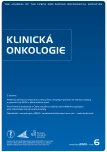Dabrafenib monotherapy in BRAF+ non-small cell lung cancer – our experience
Authors:
Ondřej Fischer 1; Vítězslav Kolek 1; Denisa Rozsívalová 1; Tomáš Tichý 2; Jozef Škarda 2; Jiří Drábek 3
Authors‘ workplace:
Klinika plicních nemocí a tuberkulózy LF UP a FN Olomouc
1; Ústav patologie, LF UP v Olomouci
2; Ústav molekulární a translační medicíny, UP v Olomouci
3
Published in:
Klin Onkol 2020; 33(6): 458-462
Category:
Case Report
Overview
Background: Activating BRAF mutations result in constitutive activation of the MAP kinase signaling cascade, stimulating cell proliferation. BRAF mutations are typical for malignant melanoma, but occur less frequently in other tumors, including in 1–2% cases of non-small cell lung cancer (NSCLC) [1,2]. Case: We present two case reports of BRAF+ NSCLC patients, treated with 3rd line dabrafenib monotherapy on our department, and also brief review of available information about dabrafenib and its use in monotherapy of BRAF+ NSCLC. Conclusion: Monotherapy with BRAF inhibitors presents a viable alternative for BRAF+ NSCLC patients, incapable of combined therapy with trametinib. The lack of proper indication and reimbursement for NSCLC cases remains a problem, and individual treatment approval is required.
Keywords:
dabrafenib – BRAF – lung cancer – non-small cell – NSCLC – monotherapy
Sources
1. Davies H, Gignell GR, Cox C et al. Mutations of the BRAF gene in human cancer. Nature 2002; 417 (6892): 949–954. doi: 10.1038/nature00766.
2. Skřičková J, David P. Cílená biologická léčba nemalobuněčného karcinomu plic. Onkologická revue 2019; 5 : 25–35.
3. Bílek O, Bohovicová L, Demlová R et al. Nemalobuněčný karcinom plic – od imunobiologie k imunoterapii. Klin Onkol 2016; 29 (Suppl 4): 78–87.
4. Li SD, Ma M, Li H et al. Cancer gene profiling in non-small cell lung cancers reveals activating mutations in JAK2 and JAK3 with therapeutic implications. Genome Med 2017; 9 (1): 89. doi: 10.1186/s13073-017-0478-1.
5. Fiala O, Pešek M, Fínek J et al. Mutace genu EGFR u pacientů s pokročilým NSCLC. Klin Onkol 2012; 25 (4): 267–273.
6. Tissot C, Couraud S, Tanguy R et al. Clinical characteristics and outcome of patients with lung cancer harboring BRAF mutations. Lung Cancer 2016; 91 : 23–28. doi: 10.1016/j.lungcan.2015.11.006.
7. Garnett MJ, Marais R. Guilty as charged: B-RAF is a human oncogene. Cancer Cell 2004; 6 (4): 313–319. doi: 10.1016/j.ccr.2004.09.022.
8. Brustugun OT, Khattak AM, Trømbork AK et al. BRAF--mutations in non-small cell lung cancer. Lung Cancer 2014; 84 (1): 36–38.
9. Planchard D, Kim TM, Mazieres J et al. Dabrafenib in patients with BRAFV600E-positive advanced non-small--cell lung cancer: a single-arm, multicentre, open-label, phase 2 trial. Lancet Oncol 2016; 17 (5): 642–650. doi: 10.1016/S1470-2045 (16) 00077-2.
10. Ngyuen-Ngoc T, Bouchaab H, Adjei AA et al. BRAF alterations as therapeutic targets in non–small-cell lung cancer. J Thorac Oncol 2015; 10 (10): 1396–1403. doi: 10.1097/JTO.0000000000000644.
11. Marchetti A, Felicioni L, Malatesta S et al. Clinical features and outcome of patients with non-small-cell lung cancer harboring BRAF mutations. J Clin Oncol 2011; 29 (26): 3574–3579. doi: 10.1200/JCO.2011.35.9638.
12. Litvak AM, Paik PK, Woo KM et al. Clinical characteristics and course of 63 patients with BRAF mutant lung cancers. J Thorac Oncol 2014; 9 (11): 1669–1674. doi: 10.1097/JTO.0000000000000344.
13. Beeram M, Patniak A, Rowinsky EK. RAF: a strategic target for therapeutic development against cancer. J Clin Oncol 2005; 23 (27): 6771–6790. doi: 10.1200/JCO.2005.08.036.
14. Auliac JB, Bayle S, Vergnenegre A et al. Non small cell lung cancer (NSCLC) patients harboring BRAF mutation: Clinical characteristics and management in real world setting. Cohort BRAF EXPLORE GFPC 02-14. [online]. Available from: https: //www.researchgate.net/publication/313325410_Non_small_cell_lung_cancer_NSCLC_patients_harboring_BRAF_mutation_Clinical_characteristics_and_management_in_real_world_setting_Cohort_BRAF_EXPLORE_GFPC_02-14.
15. Heidorn SJ, Milagre C, Whittaker S et al. Kinase-dead BRAF and oncogenic RAS cooperate to drive tumor progression through CRAF. Cell 2010; 140 (2); 209–221. doi: 10.1016/j.cell.2009.12.040.
16. Rudin CM, Hong K, Streit M. Molecular characterization of acquired resistance to the BRAF inhibitor dabrafenib in a patient with BRAF-mutant non–small-cell lung cancer. J Thorac Oncol 2013; 8 (5): e41–42. doi: 10.1097/JTO.0b013e31828bb1b3.
17. Myall NJ, Neal JW, Cho-Phan CD et al. Long-term survival of a patient with non–small-cell lung cancer harboring a V600E mutation in the BRAF oncogene. Clin Lung Cancer 2016; 17 (2): e17–21. doi: 10.1016/j.cllc.2015.12.001.
18. Paik PK, Arcila ME, Fara M et al. Clinical characteristics of patients with lung adenocarcinomas harboring BRAF mutations. J Clin Oncol 2011; 29 (15): 2046. doi: 10.1200/JCO.2010.33.1280.
19. Kocák, I. Kožní toxicita u cílené léčby dabrafenibem. Klin Onkol 2017; 30 (3): 233.
20. Tafinlar – FDA prescribing information, side effects and uses. [online]. Available from: http: //www.drugs.com/pro/dabrafenib.html.
21. Zelboraf – FDA prescribing information, side effects and uses. [online]. Available from: http: //www.drugs.com/pro/vemurafenib.html.
Labels
Paediatric clinical oncology Surgery Clinical oncologyArticle was published in
Clinical Oncology

Most read in this issue
- Immunostimulatory and anticancer effect of Reishi and Coriol extracts at the level of clinical studies and their implementation in practice
- First experience in the Czech Republic with perirectal hydrogel injection before radiotherapy for prostate cancer
- Stomatitis in mTOR inhibitors treatment and other targeted cancer therapy, possibilities of infl uencing it, and the use of local corticotherapy
- Treatment opinion of rehabilitation in sarcopenia and cachexia for oncological patients
